| Article ID | Journal | Published Year | Pages | File Type |
|---|---|---|---|---|
| 4682235 | Journal of South American Earth Sciences | 2015 | 17 Pages |
•We analysed the Chilean gravity field with different numerical methods.•We conducted constrained 3D density modelling of the subsurface.•Seismological segment boundaries correlate with segmentation of the gravity fields.•Asperities correlate with the strongest gravity gradients in the studied region.
The gravity gradients of the South American continental margin are the highest on Earth. These gradients are proxies for the strong horizontal stresses due to the convergent movement of the Nazca plate and the overriding South American plate. The frequently occurring large earthquakes in this zone suggest a correlation of gravity anomalies and seismogenic structures which is the major target of our research. Numerical analyses of the Central Andean gravity field were conducted using different techniques such as isostatic calculations, inversion and edge detection while varying the key parameters of the respective methods. Also, a constrained 3D density model was built through forward modelling of the terrestrial Bouguer anomaly. The results point out that a Vening-Meinesz model with a rigidity of 1023 Nm fits optimally the isostatic behaviour of the Central Andes. For numerical inversion the following parameters provided best results: density contrasts between 430−500 kg/m3, compensation depths of 30−40 km and a 400/300-km-wavelength filter. Moho depths obtained from the different methods agree reasonably well in the continental and oceanic area but defer the most in the transition zone between the two. In this coastal area, north-south segmentation of the residual fields is evident. The respective gravity defined segments correspond well with the extent of large earthquake rupture planes in the southern part of the investigation area. We propose that this segmentation is reflected by changing thicknesses of high density crustal bodies modelled in the 3D density model. These old batholiths fit extremely well to high-velocity domains from seismic tomography. Further seismic asperity structures also display a good correlation with different features of the residual fields.
